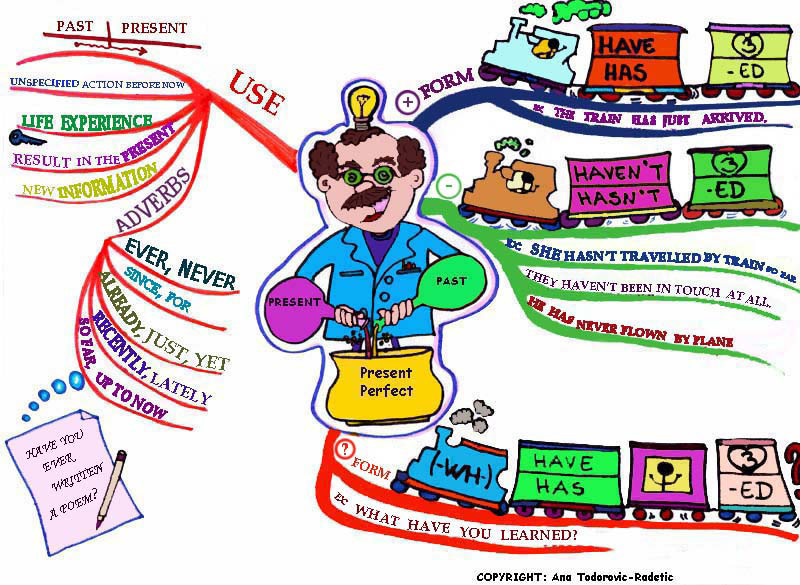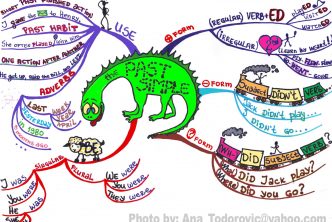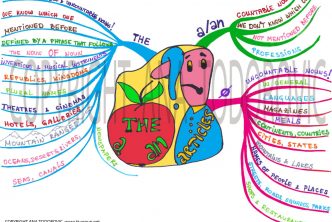Have you ever ridden a horse? Have you ever seen a chinchilla? Have you ever eaten caviar?
And, most importantly: Have you ever been confused about the Present Perfect Tense? If you have, now is the perfect moment to clear things up!
Before we start, pay attention to the tense used above – the Present Perfect itself!
Now, have a look at the enthusiastic scientist who is working hard in his laboratory. What do you think he is doing? Well, a very important thing, obviously. He is making things easier for you, mixing two ingredients – the present tense and the past tense, forming a completely new blend – the PRESENT PERFECT TENSE! Try to memorize the picture, since it is actually the basis of the Present Perfect, which represents a mixture of the past and the present… And not only that.

I Let us start from the first branch on the right, that is, the navy blue one. It explains the positive form of the tense used in a sentence. Imagine that the train is an English sentence. As you can see, every English sentence must start with a subject (of course, there are always exceptions to the rule), so the subject in the locomotive here waves to us, showing his rightful place in the world of rules.
The next part of a sentence is reserved for the predicate. Here, the predicate consists of two compartments – the auxiliary (have/has) and the main verb (past participle form).
Notice:
- has is used only for the third person singular (he, she, it)
- past participle
– if the verb is irregular, past participle is the third column of irregular verbs
– if the verb is regular, suffix –ed is added to the infinitive.
Example: The train has just arrived.
(Note: In the sentence above just is an adverb, meaning “a short time ago” and it is typically used between the auxiliary and the main verb).
II Now that we have learned the positive form, let’s proceed to explain the green branch, pertaining to the negative form. Basically, it is very simple. For negative form, auxiliaries have not/ has not (haven’t/hasn’t) are used, and again, followed by the main verb in the past participle form.
III The red branch explains the question form. The locomotive, which comes first, stands for the wh- question word (what, where, how, which, when…). It is optional (in brackets) because a question need not always begin with a question word. If you want to make a question in the Present Perfect Tense, use the auxiliary have/has, then place the subject and then the main verb, again in the past participle. (to sum up: use inversion to make questions)
IV And now, the most confusing part (the red branch) – when to use the Present Perfect Tense? The good news is – it is not confusing at all if you just evoke to your mind the picture of the scientist mixing the present and the past! So, again, the Present Perfect is always some kind of mixture of the past and the present!
-
As you can see, the first use outlined stands for an action which started in the past and is still going on in the present. It is a rather simple rule, but many students find it ambiguous since they don’t have such a tense in their language. So, let us illustrate the rule with an example:
– She has worked as a teacher for five years. (She started working as a teacher five years ago and is still working as a teacher.)
-
Secondly, use the Present Perfect Tense for an unspecified action which happened before now. What does it mean? It means that we just state what has happened, without mentioning when it happened (we do not know when it happened, or, simply, it is not important).
Example: I have planted a tree.
Note: if we state when something happened, then the Past Simple Tense should be used.
Example: I planted a tree yesterday.
-
Thirdly, whenever we talk about life experiences, we should use the Present Perfect Tense.
Examples:
– She has been to London twice.
– Have you ever ridden a horse?
-
Further on, use the Present Perfect when you talk about present results (an action in the past has a result now). As you can see in the picture, there is a small key drawn, suggesting the following example: I have lost my key (the result: Now I cannot enter my apartment). Or: She has broken her leg. (Now she cannot walk).
-
The following branch says that you should use the Present Perfect Tense when you state new information. And, if you haven’t noticed so far, pay attention to how much the Present Perfect is used in the news!
Examples: -Novak Djokovic has not lost in 42 matches in a row.
-There have been 16 major earthquakes in California since 1950.
-
When it comes to adverbs, try to memorize which adverbs go with which tense, because it will simplify things to a great extent. If you have been preparing for a test in English, remember that these adverbs require the Present Perfect tense: ever, never, since, for, already, just, yet, recently, lately, so far, up to now…
Examples:
– Have you ever been to the USA?
– She has never flown by plane.
– John has worked as an engineer since 2005.
– Maria has lived in Italy for ten years.
– Mike has already done his homework.
– They have just left.
– Haven’t you got ready yet?
– I haven’t seen Diane recently.
– She hasn’t slept much lately.
– Jane has seen that movie several times so far.
– I have worked very hard up to now.





